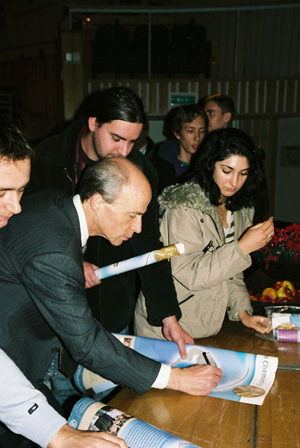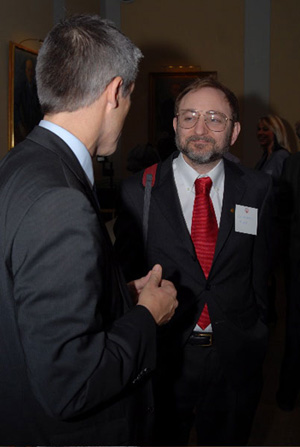December 11, 2006

After giving his Nobel lecture on Dec. 8 in Stockholm, Roger Kornberg autographs posters.
Roger Kornberg, PhD, is no stranger to the limelight, but never before has the professor of structural biology been hounded for autographs by enthusiastic fans camped outside his hotel.
Such was Kornberg’s experience this past week, as he and six other Nobel laureates, including medical school colleague Andrew Fire, PhD, visited Stockholm to receive their prizes and to partake in a series of formal ceremonies, lavish parties and crowded lectures in their honor. It is perhaps the closest a scientist will ever become to being a rock star.
“I don’t think that being singled out in this way is something that you immediately grow accustomed to,” said Kornberg, the winner of the 2006 Nobel Prize in Chemistry.
“A little bit unreal,” was the understated reaction from Fire, who shared the 2006 Nobel Prize in Physiology or Medicine with Craig Mello, PhD, of the University of Massachusetts Medical School.
Indeed, Nobel Week is a far cry from the day-to-day life of a science professor, which Fire, professor of pathology and of genetics, described as “going to the lab, doing research, teaching and thinking about science.” Instead, the winners received red-carpet treatment in Stockholm, with a whirlwind of festivities beginning Dec. 8 and culminating with a formal award ceremony and banquet—including the King of Sweden and his family—on Dec. 10.
The prizes have been awarded since 1901 on the anniversary of the death of its founder, Alfred Nobel, who left the bulk of his estate to establish the Nobel Foundation. His will stipulates that five awards should be given “to those who, during the preceding year, shall have conferred the greatest benefit on mankind.” The prize in economics was inaugurated by the Bank of Sweden in 1968.
Stockholm hosts the winners in physics, chemistry, medicine or physiology, literature and economics. The Nobel Peace Prize is presented in Oslo, Norway.
For the laureates, Nobel Week is packed with interviews, preparing lectures, attending news conferences, eating lavish dinners and hobnobbing with Swedish royalty. Yet organizers have all the week’s events planned down to the most minute detail, from where the laureates should sit in their limousines to the required dress for the banquet—white tie and tails for the men, formal evening gowns for the women. The dinner menu was kept secret until the final moments, and the Blue Room of the Stockholm City Hall hosted 1,300 guests, including Fredrik Reinfeldt, prime minister of Sweden, as well as members of the Swedish royal family and government dignitaries.
In his speech at the banquet, Kornberg captured the gravity of the occasion, thanking the Royal Swedish Academy of Sciences for bestowing the award on him, while acknowledging the many collaborators at Stanford and elsewhere, most notably his wife Yahli, who shared in his achievement. The Nobel Prize, he explained, honors more than one man’s triumphs: “In a world beset by irrational influences, with often devastating consequences, the Nobel Prizes call attention to the triumph of reason. They salute our search for understanding. They celebrate discovery of the most basic facts of nature.”
And Kornberg then cited a verse from the poet Robert Frost that he said he had often repeated to himself over the more than 20-year effort to make his discovery:
“The woods are lovely, dark and deep,
But I have promises to keep,
And miles to go before I sleep,
And miles to go before I sleep.”
If Kornberg reflected the solemn nature of the occasion, Fire expressed the joy and giddiness of the evening. His speech at the banquet added a sprig of humor, with his presentation of the “Top 10 Reasons for the Return of 2006 Nobel Laureates to Stockholm during the First Week of December 2036.” Among the reasons for returning to Sweden in 30 years was “to bask and swim in the 30-degree Celsius warmth of Stockholm's recently developed winter beach resorts.” He summed up Nobel Week when he said the No. 2 reason to return to Stockholm was “because Sweden really knows how to throw a party.”

During a Dec. 6 reception in Stockholm hosted by a Stanford alumni group, Andrew Fire chats with alumnus Bjorn Westerberg.
And the banquet certainly was evidence of that. City Hall was decorated with more than 10,000 lilies, gladioli, roses and other flowers sent from San Remo, Italy, where Alfred Nobel died in 1896. More than 60 tables were covered by 500-plus yards of linen, and the smorgasbord required 7,000 gilded plates, 5,000 glasses and 10,000 pieces of silverware.
The meal began with an appetizer of salmon and scallops with Kalix bleak roe followed by herb-baked saddle of lamb, potatoes and Jerusalem artichokes, olive oil-glazed vegetables and port wine sauce. Dessert was pineapple parfait with caramelized pineapple salad and mint. Twenty chefs prepared the spread and more than 200 servers presented it to the guests.
While the festivities attracted much attention, organizers also made sure that Nobel Week paid attention to the science that was being honored with the awards. Both Kornberg and Fire delivered their Nobel lectures on Dec. 8, providing in-depth discussions about their work. Both peppered their speeches with the names of students and colleagues who have contributed to their research over the years.
In his talk, “The Molecular Basis of Eukaryotic Transcription,” Kornberg described his multidisciplinary research into how DNA is converted into RNA, a process known as transcription. The Nobel Prize recognized his publishing in 2001 the first molecular snapshot of the protein machinery responsible for transcription in yeast—RNA polymerase II—in action. Because RNA polymerase in yeast is similar to its human cousin, the finding helped explain how cells express all the information in the human genome, and how that expression sometimes goes awry, leading to cancer, birth defects and other disorders.
Kornberg explained that one phase of his research “took 10 years, 10,000 liters of yeast and one grad student,” which sent ripples of laughter throughout the crowded lecture hall at Stockholm University as he showed a slide of former graduate student Ken Westover hanging upside down by his feet over a 200-liter yeast fermenter as he fixed a valve at the bottom of the container.
“I don’t know where we’ll find another student of that caliber,” Kornberg mused.
Fire’s lecture was titled “Gene Silencing by Double-Stranded DNA.” He described his work with Mello, in which they built on the work of other researchers to show how certain RNA molecules can be used to turn off specific genes in animal cells. The two scientists’ discovery, made while Fire was at the Carnegie Institution’s Department of Embryology in Baltimore, marked the first time that biologists were able to selectively “silence” the voice of one gene in the cacophony of the thousands that give a cell its marching orders from development to death. Their description of the process, called RNA interference or RNAi, in Nature in 1998 jumpstarted a new biological field by opening up previously inaccessible areas of research.
In his lecture, however, Fire was reluctant to assign credit for the findings to only himself and Mello. “I feel a little bit like a case study or a representative of this whole thing, rather than the lone recipient of some divine providence,” he said. “In that sense, it is kind of funny to be the person standing up in front of 1,300 people and receiving an award for work that was done by about 1,300 people.”
In addition to their Nobel activities, the two laureates also made time for a reception Dec. 6 with the Stanford Alumni Club of Sweden at the Stockholm School of Economics. Their limousine drivers followed a pre-determined route from their hotel through downtown Stockholm to comply with the strict safety protocol that required the laureates to be let out of the side of the car opposite of the street.
Bjorn Westerberg, chapter officer of the Stanford Business School Alumni Association, presented Fire and Kornberg with red, hand-painted wooden Swedish handicraft horses known as the Dalecarlian horse. “Now I can tell my students to get on their horse,” Fire quipped.
Kornberg also received an extra horse to give to his father, Arthur Kornberg, MD, Nobel laureate in Physiology or Medicine in 1959.
The alumni event was relaxed, giving the laureates the chance to chat and snack on sushi. During a brief address to the group, Kornberg said, “I was pleased that there were people here for whom Stanford has made such a difference” He described his research as “almost entirely a Stanford story.”
And Stanford was also represented at the award ceremony on Dec. 10. Philip Pizzo, MD, dean of the School of Medicine, was in the audience as the laureates received their Nobel medals—made of 18-karat green gold plated with 24-karat gold—from King Carl XVI Gustaf of Sweden.
“While I took pleasure in hearing about the accomplishment of each laureate at the ceremony at Konserthuset, it was so emotionally meaningful to witness Roger Kornberg and Andy Fire receiving their prizes from the king,” Pizzo said.
“I was proud to have a connection with them and their moment of special recognition, but also to serve as an ambassador of their many Stanford colleagues, collaborators and friends, who also share in the pride and joy of this wonderful tribute to them—and to Stanford.”
# # #
Charlotte West is a freelance writer in Stockholm.
About Stanford Medicine
Stanford Medicine is an integrated academic health system comprising the Stanford School of Medicine and adult and pediatric health care delivery systems. Together, they harness the full potential of biomedicine through collaborative research, education and clinical care for patients. For more information, please visit med.stanford.edu.